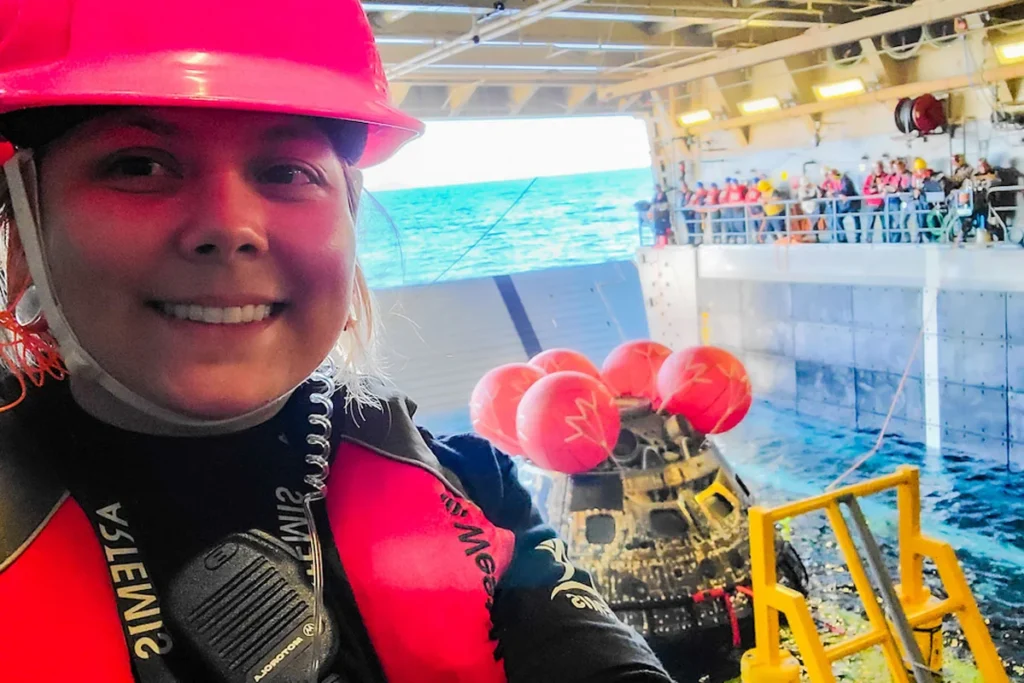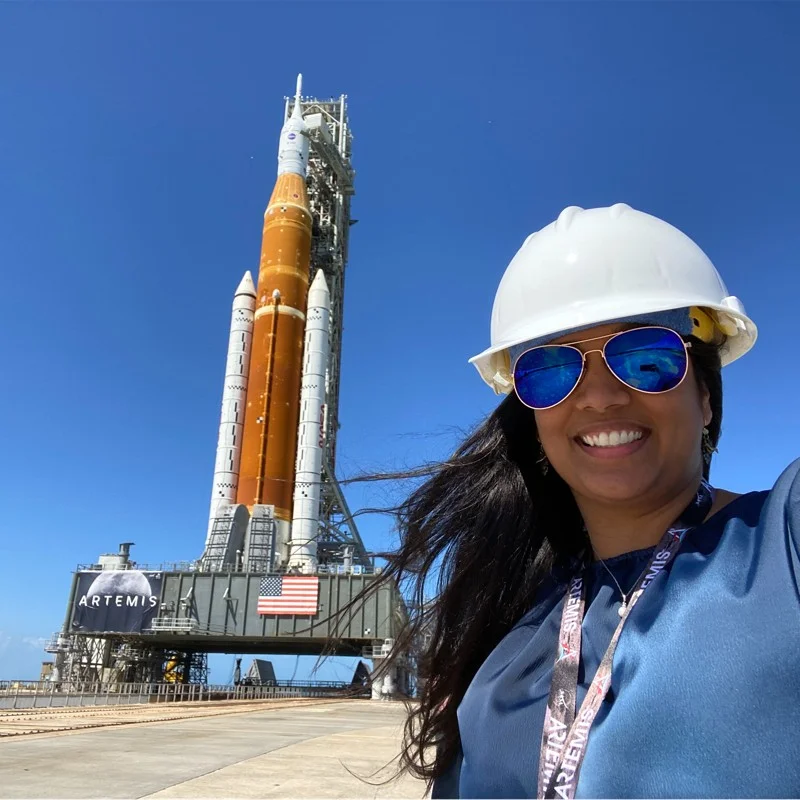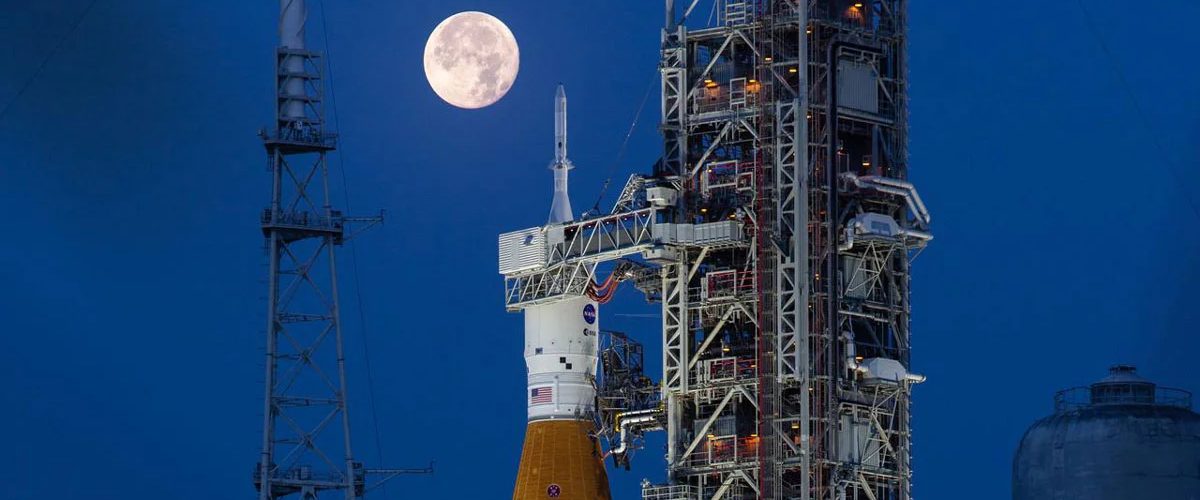If you were to parachute into the parking lots around Kennedy Space Center (KSC), you might believe you landed on an extension of UCF’s campus. Knights license plates and black-and-gold decals are everywhere.
“You should see it here during football season,” says Wes Mosedale ‘07MS, senior test director for NASA. “That’s when the colors really come out.”
The UCF logos at KSC are symbolic of deeper connections: between the university and the space program, between the past and the future, between Earth and outer space, and between the Apollo missions that sent men to the moon for the first time and the Artemis 2 mission that will send men and women to the moon at the end of 2024.
“There’s a lot of work to do between now and then,” Mosedale says.
These three UCF alumni are taking it one day and one task at a time. For them, Artemis 2 is as personal as it is historic.

The Local Girl: Paris Bishop ’19
Position: Test conductor and recovery operations manager in Pacific Ocean
Major: Aerospace engineering
I’m among the lucky few to be part of both ends of the Artemis 2 mission.
Because of my dual certifications, I’m involved with Artemis flight hardware processing, testing and rollout before launch … and then I’ll manage the landing recovery in the Pacific Ocean. It’s hard to believe that I’ll see this historic mission first-hand from pre-launch to splashdown.
For Artemis 1, I was in multiple places, too.
On launch day we had about 90 people in Firing Room 1. When we reached t-minus-12 hours my responsibilities were complete. Instead of taking up space in the Firing Room, I drove home to watch with my family. That’s how I watched shuttle launches growing up near the Cape — with the windows of our house rumbling. For Artemis 1, I watched from our yard. Then I tried to get some sleep because I had to fly to San Diego the next day and prepare for the ocean recovery.
We’re already practicing Artemis 2 recovery on a big Naval ship.
Our support teams go out for seven days at a time, pulling a capsule just like Orion from the Pacific Ocean. There’s so much public attention on the launch, but the landing recovery is sensitive, too. We were out there when the unmanned capsule from Artemis 1 came out of the sky. That was amazing. But the capsule for Artemis 2 won’t be a training article. There will be people in it.
My job at a local restaurant led to this job.
During college I worked the 6 a.m. shift as a server to pay for tuition. People from the Cape would come in for breakfast and encourage me to think big. One of them connected me for my first interview. Here I am.
I still can’t believe I’m here sometimes.
In community college, I considered all kinds of careers: marketing, TV production, even acting. I didn’t know what an engineer did, but I did like math. When I enrolled at UCF, I decided to get back into math and give this program called “aerospace” a try.
My roles say something about how far the space program has come.
This used to be for someone with multiple degrees and more experience. My first week on the job, though, I saw women in prestigious leadership roles. Working around all these great women inspired me to learn more and dream bigger.
Being an astronaut is always in the back of my mind.
I’ll need to earn my master’s degree and put the work in. But Artemis 2 is the first of a lot more launches to come. So sure, send me to the moon.

The New Mother: Laura Poliah ’10 ’12MS
Postion: Orion test engineering lead
Majors: Aerospace engineering and mechanical engineering
My life has changed since Artemis 1.
Three months after the mission, I gave birth to my son, Isaiah. We live in Merritt Island, so whenever there’s a launch now, I seize the opportunity to take him outside and feel the rumble. I know he’ll appreciate it more as he gets older. Someday, when he sees future Artemis missions, he’ll say, “My mom helped to create the capability for getting humans to space.”
See the very top of the rocket?
That’s the Orion spacecraft, which is comprised of the crew module, service module and launch abort system. It’s what our team tests — every system, one at a time, and then again after it’s all integrated. The testing ensures the spacecraft can withstand a trip into space and back. Some of the tests include vacuum and thermal tests to simulate extreme differences in pressure and temperature, acoustic tests to see there’s no loss of function from intense vibrations at liftoff or throughout the mission and end to end tests to double-check that the systems work after they’re assembled. The tests are critical to make sure everything holds together for the astronauts for Artemis 2 and beyond.
No one knew the name of the Artemis mission when I started 12 years ago.
The shuttle program was ending and a new excitement was starting to grow about something else — something big. I started working on Orion when the first structures for Artemis 1 came in, and that’s when it hit me: I was working on hardware that would someday be in space. We’re always worked ahead. When Artemis 1 launched, our test team was already performing Artemis 2 and 3 testing.
My interest in space started with books.
As a child I loved reading — books, magazines, cereal boxes, anything with words. One day I was picking up some books off the floor of the library and saw a cover with multiple galaxies. It looked interesting, so I opened the book and saw a question: “How do you know if there are planets and other solar systems?” I thought it was amazing that people do this as a job.
Mom had different ideas for my future.
She and my dad are of Indian heritage and grew up in Trinidad. They preferred I become a doctor or accountant. When I told mom I wanted to go into aerospace engineering at UCF, she jokingly said, “What are you going to do with that degree? Are you going to take me to the moon?” I distinctly remember that conversation now and smile because I do have a role in sending people back to the moon, and she’s very supportive of my career.
What we’re doing is instrumental for the future of society.
I’ve had the amazing privilege to see the Orion spacecraft come together, piece by piece, from the beginning. The Apollo missions gave us tremendous benefits, like advances in medicine and technology. We’ve already learned so much from the first Artemis launch that I have no doubt these missions will enrich lives for generations in ways we cannot yet comprehend.
